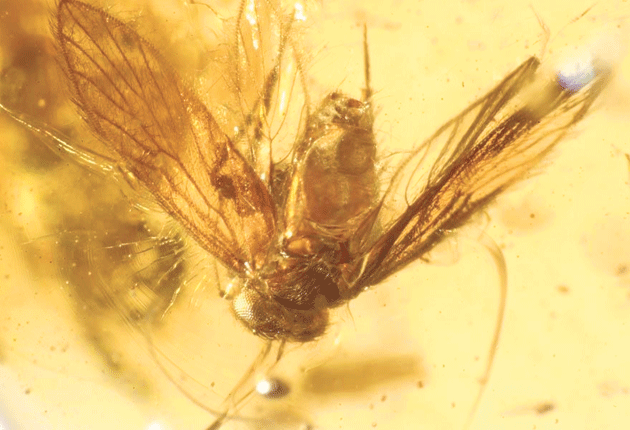Frozen in time, 50 million years ago
A treasure trove of prehistoric insects preserved in amber has been found in India. Steve Connor takes a peek into the past

Your support helps us to tell the story
From reproductive rights to climate change to Big Tech, The Independent is on the ground when the story is developing. Whether it's investigating the financials of Elon Musk's pro-Trump PAC or producing our latest documentary, 'The A Word', which shines a light on the American women fighting for reproductive rights, we know how important it is to parse out the facts from the messaging.
At such a critical moment in US history, we need reporters on the ground. Your donation allows us to keep sending journalists to speak to both sides of the story.
The Independent is trusted by Americans across the entire political spectrum. And unlike many other quality news outlets, we choose not to lock Americans out of our reporting and analysis with paywalls. We believe quality journalism should be available to everyone, paid for by those who can afford it.
Your support makes all the difference.A collection of beautifully preserved bees, ants, spiders and other small prehistoric creatures that lived 50 million years ago have been unearthed in a huge amber deposit in India.
Scientists said that the fossilised globules of tree resin have entombed a spectacular menagerie of insects that had survived the extinction of the dinosaurs and were living at a time before mammals had evolved.
The amber deposit is the first to be found in India and may be larger than the Baltic deposits – in Russia, Poland, Ukraine and Germany – which are the biggest in the world and have proved a rich source of the semi-precious gemstone for more than 200 years.
Amber forms when the soft, sticky sap of trees solidifies into hard lumps of resin which, when buried, become fossilised into a substance valued for its colour, translucence and natural organic beauty. The resin produced by the trees has antiseptic properties to protect the plant against attack from fungi and bacteria, a feature which also helps to preserve any insects or small animals that become trapped in the soft resin before it solidifies.
The new deposits, which the scientists have likened to a huge cache of herbal cough drops, were found in the open-cast coal mines of the Cambay region of north-west India.
The researchers said that an analysis of the amber shows that it was formed from the resin of a family of tropical hardwood trees that still exist in south-east Asia.
Insects found in Baltic amber are often empty shells because their inner, soft parts have dissolved away. However, scientists have found that the Indian amber preserves the insects intact, allowing the researchers to study them whole in fine detail.
"We are able to dissolve the amber and get the specimens completely out," said Professor Jes Rust of Bonn University in Germany, who led the team.
"This is really outstanding. It's like getting a complete dinosaur out of the amber and being able to put it under the microscope," Professor Rust said.
The story of a prehistoric mosquito that had just dined on the blood of a dinosaur before being trapped in tree resin formed part of the 1993 film Jurassic Park, based on the book of the same name by Michael Crichton, where dinosaur DNA is recovered from the insect and used to bring the giant creatures back to life. However, Professor Rust said that the possibility of getting any genetic material from the insects trapped in the Indian amber is next to zero.
"You will never find ancient DNA in amber. It is completely destroyed and deteriorates after a couple of hundred thousand years. Jurassic Park is wonderful science fiction," he said.
Nevertheless, the scientists have already found more than 700 specimens trapped in the Indian amber. They are mostly insects, such as ants, bees and termites, but they also include spiders, mites and parts of plants. One species of ant belongs to a genus that is only found alive today in Australia.
Dating of the coal seams where the amber was recovered shows that the trapped animals lived between 52 and 50 million years ago, when the Indian subcontinent was still an island that was moving at the relatively fast pace of 15 to 25 centimetres a year towards Asia, before colliding with the continent to form the Himalayas.
Already, the scientists have shown that the similarities of the species in the amber to species living in Asia and Europe have exploded a theory known as the "biotic island ferry", where India was thought to have carried much of its wildlife to Asia, where it then escaped to populate the Eurasian landmass.
"The idea is called the biotic ferry because India was isolated for millions of years after being connected to the ancient continent of Gondwanaland. After the collision between India and Asia, its fauna was able to jump from India to Asia where it spread all over Europe," Professor Rust said. "What we found in this 52 million year old amber is that the insects contained in it already show close connections to European fauna of almost the same time.
"The amber shows, similar to an old photo, what life looked like in India just before the collision with the Asian continent. The insects trapped in the fossil resin cast a new light on the history of the sub-continent," he added.
Indian scientist Ashok Sahni from the University of Lucknow found the amber while looking for other fossils.
"He was digging for mammoth fossils and he came across these strange stones which be brought to Germany to show me because there were no amber specialists in India," Professor Rust said. "There is an enormous volume of amber to be found. This is just the beginning."
Join our commenting forum
Join thought-provoking conversations, follow other Independent readers and see their replies
Comments